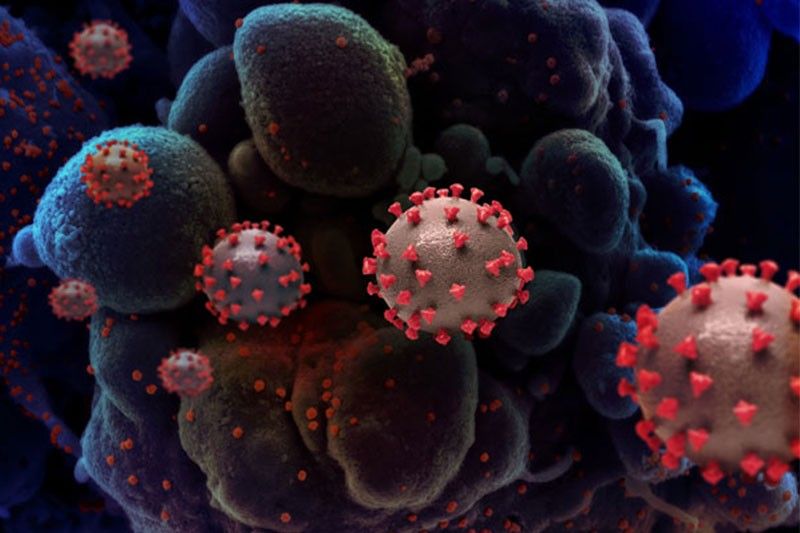Coronavirus mutation partially explains rise in COVID-19 cases in Philippines — study

But eased quarantine seen as 'main driving source' of increase in cases
MANILA, Philippines — The presence of a mutation of the novel coronavirus and the relaxation of quarantine measures explain the rapid rise of COVID-19 cases in the country, according to a Philippines-US joint study.
The joint research published November 30 found that the D614G mutation of SARS-CoV-2, the virus that causes COVID-19, was present in a majority of specimens collected from military and civilian patients between June and July.
This study was conducted by the Armed Forces Forces of the Philippines V. Luna Medical Center (VLMC) and the US Department of Defense - Armed Forces Research Institute of Medical Sciences.
"In this study, we found the D614G mutation in the majority of the sequences from specimens collected from the end of June 2020," the study said.
This finding was also associated with the spike of COVID-19 cases at VLMC in the Philippines since July.
The presence of the D614G mutation "may partially explain" the rapid rise of cases in the country, the study said.
Noting that movement restrictions were downgraded to general community quarantine (GCQ) in Metro Manila starting in June, reseachers said the more relaxed quarantine measures might have been the "main driving source" of the increase in COVID-19 cases.
"Alternatively, this might have also facilitated the dissemination of strains such as GR/B.1.1 and GR/B1.1.28 with the D614G mutation, which led to the replacement of other circulating SARS-CoV-2 strains before June 2020," the study read.
"Strains with this particular mutation may be replacing the original SARS-CoV-2 strain/s circulating before June 2020," it concluded, referring to the D614G mutation.
The study also noted that particular strains of the coronavirus may present different symptoms or transmission efficiency.
The D614G mutation has been associated with higher titers of SARS-CoV-2 pseudo viruses (a retrovirus that can integrate the envelope glycoprotein of another virus to form a virus with an exogenous viral envelope with the genome retaining the characteristics of the original retrovirus) and higher viral RNA levels in vitro13 as well as enhanced SARS-CoV-2 replication in the upper airway using a primary human airway tissue model,14 though further studies are still needed to definitely determine whether this mutation translates to an actual impact on transmission efficiency15 or disease severity.
In August, the Philippine Genome Center (PGC) said a new mutation of SARS-CoV-2, which they called G614, has been detected in the Philippines.
The new strain of COVID-19 is believed to more infectious than the original D614 genotype, which first emerged in Wuhan, China late last year.
D614 was detected when the first case in the Philippines was reported in March. In its study released August, genomic researchers detected both the D614 and the G614 in the positive samples they collected.
The PGC, however, clarified that they did not find any evidence on the new mutation's impact on disease severity.
“There is still no definitive evidence showing that carriers of the G614 variant are actually more transmissible than those with D614, and the mutation does not appear to substantially affect clinical outcomes as well,” PGC said.
As of December 10, the Philippines recorded a total of 445,540 COVID-19 cases, 27,781 or 6.2% of which are active cases.
According to Johns Hopkins University, the Philippines ranks second in Southeast Asia and 27th globally in terms of coronavirus cases. — with report from Gaea Katreena Cabico
Other regions and provinces in the Philippines considered moderate and low-risk areas will be placed under general community quarantine starting May 1. Bookmark this page for updates. (Main image by The STAR/Edd Gumban)
The health department registers 1,474 new COVID-19 cases, bringing the national caseload to 2,824,499.
- New deaths: 205
- New recoveries: 2,565
- Total active cases: 22,070
The Department of Health reports an additional 1,485 COVID-19 infections, bringing the national tally to to 2,823,210.
- New deaths: 277
- New recoveries: 1,393
- Total active cases: 23,200
The Department of Health registers 1,297 new COVID-19 cases, biringing the national caseload to 2,821,753.
- New deaths: 305
- New recoveries: 1,956
- Total active cases: 23,158
The Department of Health registers 2,646 new COVID-19 cases, bringing the national tally to 2,809,311.
- Active cases: 29,138 or 1.0% of the total
- Deaths: 99, pushing the count to 44,665
- Recoveries: 4,029 bringing the number to 2,735,508
The Department of Health logs 1,409 new COVID-19 cases, bringing the national tally to 2,806,694.
- Active cases: 30,544 or 1.1% of the total
- Deaths: 46, pushing the count to 44,567
- Recoveries: 2,941 bringing the number to 2,731,583
- Latest
- Trending

































